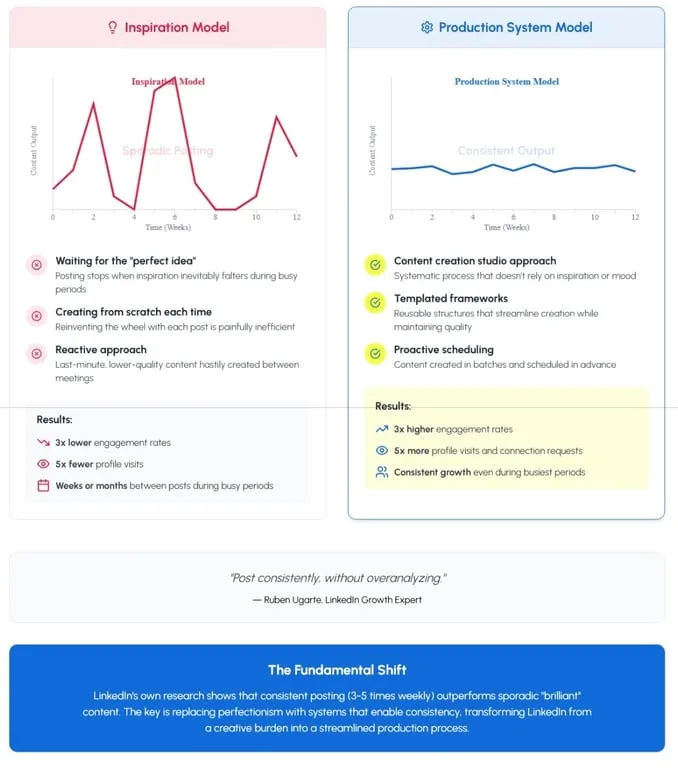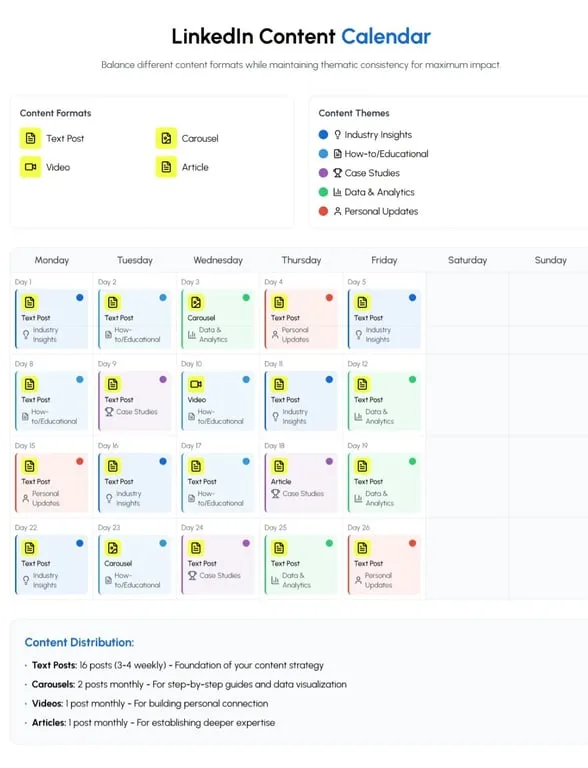The greatest myth in LinkedIn content creation? That you need to wait for inspiration to strike.
While most professionals treat LinkedIn as a daily creative challenge-staring at blank screens and hoping for brilliant ideas-high-performing agency owners and founders take a different approach.
They've built content creation studios: systematic frameworks that transform LinkedIn from a daily struggle into a streamlined production process.
This guide will show you exactly how to build your own LinkedIn content studio-a repeatable system that delivers consistent quality while respecting your limited time as a busy professional.

Why You Need a Content Creation Studio
A content creation studio isn't necessarily a physical space but rather a systematic approach to producing LinkedIn content that includes clear processes, templates, schedules, and quality controls.
The Failure of Traditional Approaches
Most professionals struggle with LinkedIn content because they rely on inspiration rather than systems:
The inspiration trap: Waiting for the "perfect idea" leads to inconsistent posting and lost momentum
The blank page problem: Creating content from scratch each time wastes hours of valuable time
Reactive mode: Last-minute content creation results in lower quality and strategic alignment
Individual heroics: Depending solely on your own creative energy becomes unsustainable
According to LinkedIn branding discussions on Reddit, successful creators consistently advise to "Post consistently, without overanalyzing." This wisdom highlights the importance of systems over perfectionism.
As one agency owner shared in a content creation thread: "When I switched from 'whenever I have an idea' to a scheduled system with templates, my content quality improved while my creation time dropped by 70%."
Building Your Content Studio Foundation
Before implementing production processes, establish these foundational elements:
Content Themes: Your Strategic Framework
Identify 3-5 core themes that align with your expertise and audience needs. These themes become the pillars of your content strategy.
Strong themes typically focus on:
Specific client problems your agency solves exceptionally well Unique methodologies you've developed through experience Industry insights where you have distinctive perspective Transformation stories demonstrating your impact
For example, a digital marketing agency might focus on themes like data-driven campaign optimization, cross-channel measurement systems, conversion psychology, and scaling strategies.
According to LinkedIn growth strategists, "Becoming the expert in a specific niche" generates significantly more engagement than generic content.
Content Mix: Balancing Value and Promotion
Create a balanced approach that prioritizes audience value:
Educational content (40%): How-tos, guides, and explanations that solve specific problems Thought leadership (30%): Original perspectives and analyses that demonstrate strategic thinking Social proof (20%): Case studies and results that validate your expertise Promotional content (10%): Service offerings and availability updates
This 40/30/20/10 ratio ensures you're consistently providing value before asking for anything in return-a principle consistently emphasized in social media strategy discussions.
Content Calendar: From Random to Strategic
Transform random posting into strategic communication with a structured calendar:
Theme days create predictable content patterns (e.g., "How-to Tuesdays" or "Case Study Fridays") Format rotation maintains audience interest through varied content types Creation blocks allocate specific time for batched content development Flexibility space allows for timely, reactive content when appropriate
As content marketing experts note, "Consistent posting schedules signal reliability to both your audience and the LinkedIn algorithm."

Content Creation Workflows: The Studio in Action
Efficient workflows form the operational core of your content studio.
Batch Creation: The Productivity Multiplier
Rather than creating posts daily, implement a batching system that dramatically improves efficiency:
Schedule dedicated blocks: Set aside 2-3 hours weekly for focused content creation
Create multiple pieces: Develop 1-2 weeks of content in each session
Draft in documents: Prepare posts in a document before transferring to LinkedIn
Optimize environment: Eliminate distractions during creation sessions
This approach typically reduces content creation time by 30-40% compared to daily creation, according to content creation efficiency discussions.
Content Templates: Eliminating the Blank Page
Develop templates for recurring content types to streamline creation:
Case study framework: Challenge → Solution → Results → Lessons
How-to structure: Problem → Steps → Outcome → Application
Analysis template: Trend → Impact → Opportunity → Action
Opinion format: Conventional wisdom → Counterpoint → Evidence → New perspective
These templates eliminate the "blank page" problem that causes many professionals to procrastinate on content creation.
As one content creator noted in a LinkedIn post ideas discussion, "Having frameworks saves me from staring at the screen wondering where to start."
Content Repurposing System: Maximize Every Asset
Implement a strategic approach to content repurposing that multiplies your output:
Client presentations → carousel posts: Transform client-specific presentations into anonymized LinkedIn carousels
Blog articles → post series: Convert comprehensive blog content into a week-long series of focused LinkedIn posts
Webinars → micro-content: Extract key points from webinars to create standalone updates
FAQs → educational posts: Compile frequently asked client questions into valuable educational content
According to content repurposing experts, "No content is limited to single-use." This approach allows you to generate at least 3-5 LinkedIn posts from each major content piece you create.
Technology Stack: Powering Your Studio
The right tools can dramatically improve your content production efficiency.
AI-Assisted Content Creation
Modern AI tools can accelerate your LinkedIn content creation without sacrificing authenticity:
Idea generation: Get content suggestions based on your defined themes
Multiple variations: Create alternative versions with different tones and formats
Voice consistency: Maintain your authentic style through advanced AI
Optimization: Identify high-performing patterns in your content
Tools like LiGo offer content theme features that ensure all generated content aligns with your strategic direction while saving significant creation time.
Content Organization Systems
Implement systems to organize your growing content assets:
Idea repository: Create a centralized location for capturing content inspiration
Content library: Develop a searchable archive of your published material
Asset management: Organize visuals, templates, and reference materials
Performance tracking: Maintain records of content metrics and insights
Proper organization prevents constantly "reinventing the wheel" with each new post. As noted in discussions about content systems, "The most successful creators spend more time organizing than creating."
Scheduling and Analytics
Leverage tools that streamline publishing and provide performance insights:
Content scheduling: Use LinkedIn's native scheduler or dedicated tools
Performance monitoring: Track engagement metrics across your content
Audience insights: Analyze when your audience is most active
Optimization data: Identify patterns in your highest-performing posts
LiGo's analytics capabilities can help you understand which content types drive the most engagement, allowing you to continuously refine your approach.
Quality Control: Maintaining Excellence at Scale
Systematic quality control ensures your content remains exceptional even as you scale production.
The Content Review Process
Establish a quality assurance system that catches issues before publication:
Strategic alignment check: Ensure each piece supports your business objectives
Value assessment: Verify that each post provides clear benefit to your audience
Brand voice review: Check for consistency in tone and messaging
Technical verification: Examine for grammatical errors and formatting issues
In social media strategy discussions, professionals emphasize that "quality control processes become even more important as content volume increases."
Performance Analysis Cycle
Implement a regular review process to continuously improve your content:
Weekly metrics review: Track engagement statistics for recent posts
Monthly content audit: Analyze patterns in your highest-performing content
Quarterly strategy adjustment: Refine your approach based on performance data
Annual content planning: Develop broad themes and initiatives for the coming year
This systematic approach transforms content from a creative guessing game into a data-informed strategy. According to LinkedIn strategy experts, "Regular performance analysis is what separates strategic creators from content hobbyists."
Scaling Your Content Studio
As your LinkedIn strategy matures, implement these approaches to expand your impact.
Team Integration: Multiplying Capacity
Involve team members in your content creation studio to expand capacity while maintaining quality:
Theme specialists: Assign specific content areas to subject matter experts
Style guidelines: Create clear documentation for maintaining consistent voice
Approval workflows: Implement efficient review processes
Recognition systems: Acknowledge team contributions to content success
This collaborative approach expands your content capacity while leveraging diverse expertise. As content team leaders note, "The key is clear processes-without them, team content quickly becomes inconsistent."
Cross-Platform Integration: Maximizing ROI
Extend your content studio across multiple channels for greater impact:
Platform adaptation: Modify LinkedIn content for other social networks
Marketing integration: Connect social content with email and other channels
Message alignment: Ensure consistent positioning across all touchpoints
Unified analytics: Track performance across your entire digital ecosystem
This integrated approach maximizes the return on your content investment by ensuring each asset works across multiple channels.
Overcoming Common Challenges
Finding Time: The Busy Professional's Dilemma
For time-constrained agency owners, these approaches make content creation manageable:
Calendar blocking: Schedule non-negotiable time for your content studio
AI acceleration: Use tools like LiGo's post generator to streamline creation
Template utilization: Create frameworks that eliminate starting from scratch
Strategic batching: Produce multiple content pieces in focused sessions
As one agency owner shared in a LinkedIn strategy discussion, "I found that 90 minutes of focused content creation each Monday morning gave me better results than trying to find 15 minutes every day."
Maintaining Quality: The Scale Challenge
As production increases, maintain quality through systematic approaches:
Brand guidelines: Document your voice, style and content standards
Quality checklists: Create review processes for all content
Feedback loops: Gather input on content performance
Continuous learning: Stay updated on LinkedIn best practices
Quality control becomes increasingly important as you scale content production, preventing the dilution of your personal brand.
Idea Generation: Beyond Creative Block
Implement systematic idea sourcing to eliminate creative block:
Content swipe file: Maintain a collection of inspiring examples
Client question log: Document frequently asked questions as content seeds
Trend monitoring: Set alerts for industry developments
Competitive analysis: Identify content gaps in your market
According to content creation experts, "The most successful LinkedIn creators are collectors-they're constantly gathering ideas from client conversations, industry news, and competitor content."
From Theory to Application: Your Next Steps
Building a content creation studio is an evolution, not a revolution. Start with these manageable steps:
-
Define your core themes: Identify 3-5 strategic content pillars
-
Create basic templates: Develop frameworks for your most common post types
-
Schedule creation time: Block 90 minutes weekly for content development
-
Begin batching: Create at least one week of content in advance
-
Track performance: Note which content types generate the most engagement
As your system matures, gradually add more sophisticated elements like team integration, advanced analytics, and cross-platform strategies.
Remember that the perfect system evolves through implementation and iteration. Start with the foundational elements, establish consistent habits, and refine your approach based on real-world results.
The Studio Mindset: From Creator to Producer
The most important shift in building your content studio is mental: moving from seeing yourself as a content creator to viewing yourself as a content producer.
A creator relies on inspiration and individual effort. A producer builds systems that reliably generate quality results regardless of daily motivation or creative energy.
This producer mindset transforms LinkedIn from a daily creative challenge into a systematic business development asset that builds your authority and attracts ideal clients-without consuming hours of your valuable time each day.




